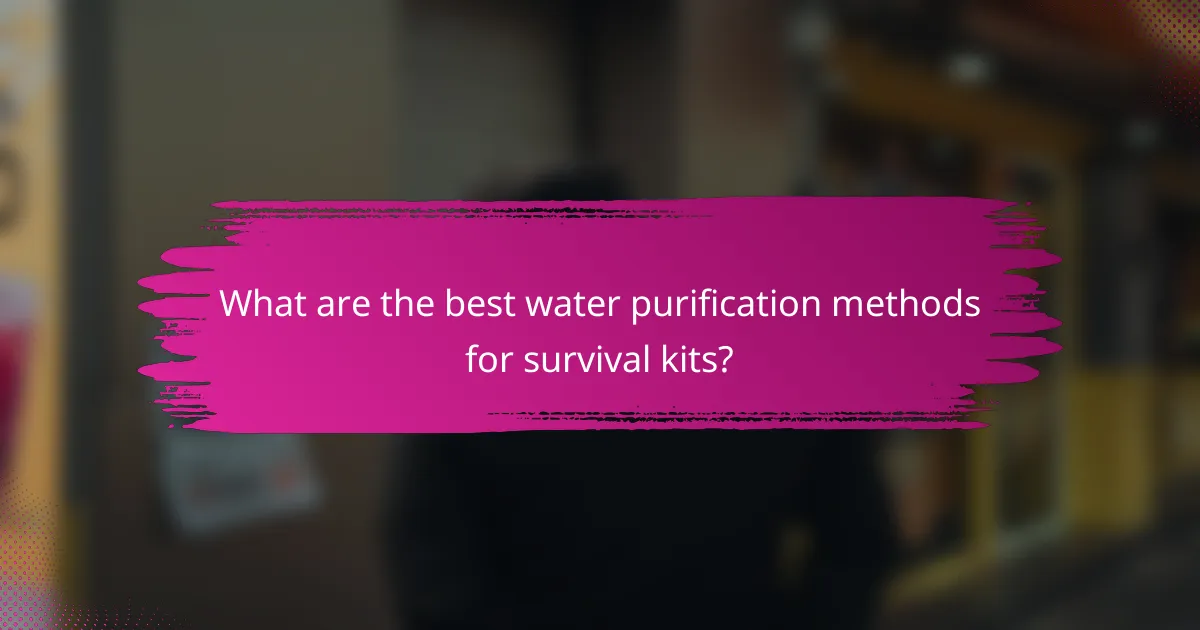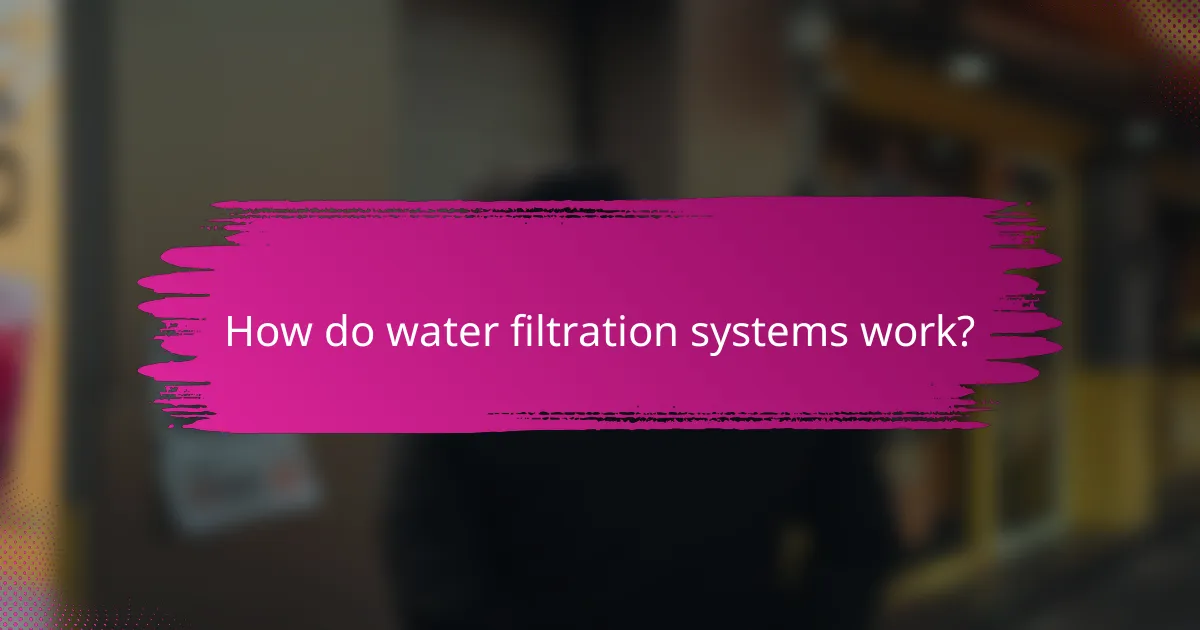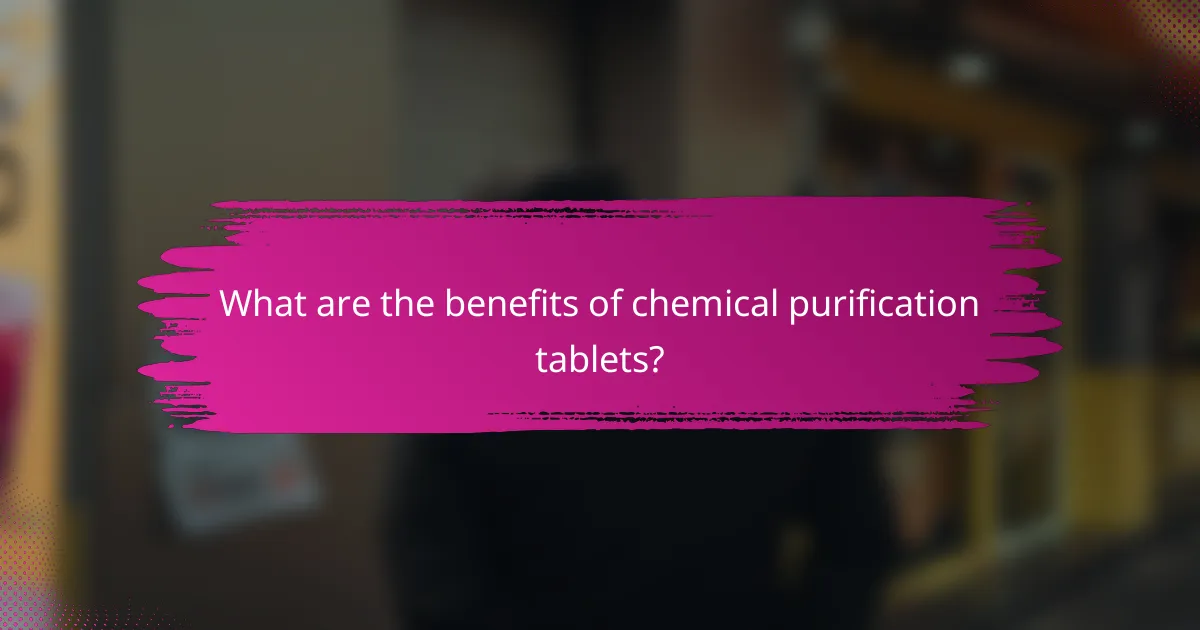In survival situations, having reliable water purification methods is crucial for ensuring safe drinking water. Essential techniques include boiling, filtration, chemical treatment, UV light, and solar distillation, each offering unique benefits depending on the circumstances. Understanding these methods can help you effectively address water safety in emergencies.

What are the best water purification methods for survival kits?
The best water purification methods for survival kits include boiling, filtration, chemical treatment, UV light, and solar distillation. Each method has its advantages and considerations, making them suitable for different situations and environments.
Boiling water
Boiling water is one of the simplest and most effective methods for purifying water. Heating water to a rolling boil for at least one minute kills most pathogens, including bacteria, viruses, and parasites.
When using this method, ensure you have a reliable heat source, such as a camping stove or fire. Keep in mind that boiling does not remove chemical contaminants, so it’s best used when biological threats are the primary concern.
Water filtration systems
Water filtration systems use physical barriers to remove impurities from water. These systems can range from portable filters to larger, more complex setups, and are effective at removing bacteria, protozoa, and sediment.
When selecting a filter, look for one that meets NSF/ANSI standards for water purification. Consider the filter’s flow rate and lifespan, as well as whether it can handle the specific contaminants in your area.
Chemical purification tablets
Chemical purification tablets, typically containing chlorine or iodine, are a lightweight and convenient option for treating water. They work by killing pathogens, making water safe to drink.
Follow the manufacturer’s instructions for dosage and wait time, usually around 30 minutes. Be aware that some people may have sensitivities to iodine, and chemical treatments may leave an aftertaste.
UV light purifiers
UV light purifiers use ultraviolet radiation to deactivate microorganisms in water. This method is effective against bacteria, viruses, and protozoa, making it a reliable choice for purification.
To use a UV purifier, simply submerge the device in water and activate it according to the instructions. Ensure the water is clear, as turbidity can reduce effectiveness. Battery life and UV lamp lifespan are important factors to consider when selecting a device.
Solar water distillation
Solar water distillation uses sunlight to evaporate water, leaving contaminants behind. This method is particularly useful in sunny climates and can produce clean water from salty or polluted sources.
To create a solar still, dig a shallow pit, place a container in the center, and cover it with clear plastic. The sun will heat the water, causing it to evaporate and condense on the plastic, dripping into the container. This method is slow but effective for emergency situations.

How do water filtration systems work?
Water filtration systems remove impurities and contaminants from water, making it safe for drinking and other uses. They typically employ various methods to achieve this, including physical barriers, chemical processes, and biological treatments.
Activated carbon filters
Activated carbon filters use a porous form of carbon to trap impurities through adsorption. As water passes through the filter, contaminants like chlorine, sediment, and volatile organic compounds adhere to the carbon surface, effectively purifying the water.
These filters are widely used in household water pitchers and under-sink systems. They are effective at improving taste and odor but may not remove all pathogens or heavy metals, so additional treatment may be necessary for complete purification.
Reverse osmosis systems
Reverse osmosis (RO) systems employ a semi-permeable membrane to remove a wide range of contaminants from water. Water is forced through the membrane, which allows only water molecules to pass while blocking larger particles, including salts, bacteria, and heavy metals.
RO systems are highly effective and can remove up to 99% of dissolved solids. However, they require regular maintenance and can waste water during the filtration process, so users should consider their water supply and disposal options.
Gravity-fed filters
Gravity-fed filters rely on gravity to pull water through a filtration medium, typically ceramic or activated carbon. As water flows downwards, contaminants are trapped, resulting in cleaner water at the bottom of the container.
These systems are simple to use and do not require electricity, making them ideal for emergency situations or remote locations. However, they may take longer to filter water compared to pressurized systems, and users should ensure the filter is regularly cleaned to maintain effectiveness.

What are the benefits of chemical purification tablets?
Chemical purification tablets are an effective and convenient method for making water safe to drink. They work by releasing chemicals that kill harmful pathogens, making contaminated water potable in a relatively short time.
Portability
Chemical purification tablets are highly portable, making them ideal for outdoor activities like camping, hiking, or emergency preparedness. They are lightweight and compact, allowing you to easily carry them in a backpack or emergency kit without adding significant weight or bulk.
Most tablets come in small, resealable packages, which protect them from moisture and damage. This ensures that you can take them anywhere without worrying about them breaking or becoming ineffective.
Ease of use
Using chemical purification tablets is straightforward and requires minimal preparation. Typically, you just need to add the recommended number of tablets to a specified volume of water, wait for the designated time, and then your water is ready to drink.
This method does not require any special equipment or technical skills, making it accessible for anyone. Just be sure to follow the instructions carefully to ensure effective purification.
Long shelf life
Chemical purification tablets generally have a long shelf life, often lasting several years if stored properly. This makes them a reliable option for emergency kits, as you can keep them on hand without frequent replacements.
Check the expiration date on the packaging and store them in a cool, dry place to maximize their effectiveness. Regularly reviewing your emergency supplies can help ensure you always have functional tablets when needed.

What should you consider when choosing a water purification method?
When selecting a water purification method, consider the quality of your water source, the size of your group, and the resources available to you. These factors will influence the effectiveness and practicality of your chosen purification technique.
Water source quality
The quality of your water source is crucial in determining the appropriate purification method. If the water is heavily contaminated with pathogens or chemicals, more advanced methods like reverse osmosis or UV purification may be necessary. In contrast, clear water from a flowing stream may only require basic filtration or boiling.
Assess the source for visible contaminants, odor, and turbidity. If possible, test the water for specific pollutants, especially if you suspect chemical contamination. Knowing the source’s quality helps in selecting the most effective and efficient purification method.
Group size
Group size significantly impacts the choice of water purification method. For small groups, portable filters or purification tablets may suffice, while larger groups may require more robust systems like gravity filters or larger UV units. Consider how much water each person will need daily, typically around 2-3 liters per person in survival situations.
Plan for peak usage times, such as cooking or cleaning, to ensure that your purification method can meet demand. Always have a backup method in case your primary choice fails or is insufficient for your group size.
Available resources
Your available resources, including time, equipment, and energy sources, will dictate which water purification methods are feasible. For example, if you have access to firewood, boiling water may be a straightforward option. However, if you lack fuel, chemical treatments or solar disinfection might be more practical.
Evaluate the tools you have on hand, such as filters, tablets, or UV lights, and consider their effectiveness and ease of use. Always keep in mind the maintenance and replacement needs of any equipment you choose, as this can affect long-term viability in survival situations.

What are the limitations of boiling water for purification?
Boiling water is a common method for purification, but it has several limitations that can affect its effectiveness. While it kills most pathogens, it may not address all contaminants, and the process can be impractical in certain situations.
Time-consuming
Boiling water requires time to reach the necessary temperature, typically around 100°C (212°F). Depending on the volume of water, this can take several minutes to over an hour. Additionally, you must maintain the boil for at least one minute to ensure effective pathogen elimination, which can be challenging in emergency situations.
Fuel requirements
Using boiling as a purification method necessitates a reliable fuel source, such as wood, propane, or charcoal. In remote areas or during disasters, fuel may be scarce or unavailable, making it difficult to boil water when needed. Consider alternative purification methods that do not rely on fuel, especially in survival scenarios.
Not effective against chemicals
Boiling water does not remove chemical contaminants, such as heavy metals, pesticides, or industrial pollutants. These substances can remain in the water even after boiling, posing health risks. For comprehensive purification, consider using activated carbon filters or chemical treatments alongside boiling to address chemical impurities.

How can you enhance your water purification strategy?
Enhancing your water purification strategy involves understanding various methods and selecting the most effective ones for your needs. Consider factors like the source of water, available resources, and specific contaminants to tailor your approach.
Boiling
Boiling is one of the simplest and most effective methods for purifying water. By heating water to a rolling boil for at least one minute, you can kill most pathogens, including bacteria, viruses, and parasites. At higher altitudes, extend the boiling time to three minutes to ensure safety.
While boiling is effective, it requires a heat source and can be time-consuming. It’s essential to let the water cool before consumption, and you may want to filter out any sediment beforehand for better taste.
Filtration
Water filtration systems can remove impurities and improve taste. Options range from portable filters to larger home systems, and they often utilize activated carbon, ceramic, or reverse osmosis technology. Choose a filter based on the contaminants you expect in your water source.
Keep in mind that not all filters remove viruses, so check specifications carefully. Regular maintenance and replacement of filter elements are crucial for optimal performance and safety.
Chemical Purification
Chemical purification involves using substances like chlorine or iodine to disinfect water. These chemicals can effectively kill bacteria and viruses, making water safe to drink. Follow the manufacturer’s instructions for dosage and wait times to ensure effectiveness.
Be aware that chemical purification may leave an aftertaste and is less effective against certain parasites. It’s advisable to use this method in conjunction with filtration for best results.
UV Light Treatment
Ultraviolet (UV) light treatment is a modern method that uses UV radiation to kill microorganisms in water. Portable UV purifiers are available for outdoor use and can treat water in just a few minutes. This method is effective against bacteria, viruses, and protozoa.
However, UV treatment requires clear water for maximum effectiveness, as turbidity can hinder the process. Ensure the device is fully charged and follow the manufacturer’s guidelines for optimal use.
Solar Water Disinfection (SODIS)
Solar Water Disinfection (SODIS) is an eco-friendly method that uses sunlight to purify water. By filling clear plastic bottles with water and placing them in direct sunlight for six hours or more, UV rays can kill harmful microorganisms. This method is particularly useful in sunny climates.
While SODIS is low-cost and simple, it requires adequate sunlight and may not be effective in cloudy weather. Always ensure the bottles are clean and free from scratches to maximize UV exposure.
